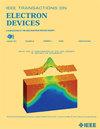不同温度下质子辐照对DDR4 DRAM的单事件扰动和总电离剂量效应
IF 3.2
2区 工程技术
Q2 ENGINEERING, ELECTRICAL & ELECTRONIC
引用次数: 0
摘要
在48 mev质子辐射和153 ~ 373 K温度下,研究了单事件扰动(SEU)和总电离剂量(TID)对DDR4动态随机存取存储器(DRAM)的影响。seu诱导的误差密度在373 K时达到最大值$5.59\乘以10^{-{6}}$,在153 K时达到最小值$9.77\乘以10^{-{6}}$,这与温度升高时栅极诱发漏极(GIDL)的增加有关。待测器件(DUT)在153,300和373 K下辐照后,估计tid诱导的误差密度。在373 K时,界面陷阱的产生比153 K时更多,导致tid诱导的误差密度增加。300 K时的误差密度是373 K时的1.1倍。这是因为在373 K下辐照的DUT比在300 K下辐照的DUT更有利于通过退火恢复缺陷。本文章由计算机程序翻译,如有差异,请以英文原文为准。
Single-Event Upset and Total Ionizing Dose Effects on DDR4 DRAM Due to Proton Irradiation Under Different Temperatures
In this study, single-event upset (SEU) and total ionizing dose (TID) effects on DDR4 dynamic random access memory (DRAM) under 48-MeV proton radiation and various temperatures (153–373 K) were investigated. The SEU-induced error density reached a maximum of $5.59\times 10^{-{6}}$ at 373 K and a minimum of $9.77\times 10^{-{10}}$ at 153 K, which correlates with the increase in gate-induced drain leakage (GIDL) as temperature rises. After the device under test (DUT) was irradiated at 153, 300, and 373 K, the TID-induced error density was estimated. The generation of interface traps was higher at 373 K than at 153 K, leading to an increase in the TID-induced error density. However, the error density at 300 K was 1.1 times as high as that at 373 K. This occurs because the DUT irradiated at 373 K is more favorable for defect recovery via annealing than at 300 K.
求助全文
通过发布文献求助,成功后即可免费获取论文全文。
去求助
来源期刊

IEEE Transactions on Electron Devices
工程技术-工程:电子与电气
CiteScore
5.80
自引率
16.10%
发文量
937
审稿时长
3.8 months
期刊介绍:
IEEE Transactions on Electron Devices publishes original and significant contributions relating to the theory, modeling, design, performance and reliability of electron and ion integrated circuit devices and interconnects, involving insulators, metals, organic materials, micro-plasmas, semiconductors, quantum-effect structures, vacuum devices, and emerging materials with applications in bioelectronics, biomedical electronics, computation, communications, displays, microelectromechanics, imaging, micro-actuators, nanoelectronics, optoelectronics, photovoltaics, power ICs and micro-sensors. Tutorial and review papers on these subjects are also published and occasional special issues appear to present a collection of papers which treat particular areas in more depth and breadth.
 求助内容:
求助内容: 应助结果提醒方式:
应助结果提醒方式:


